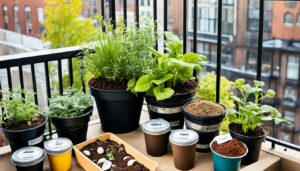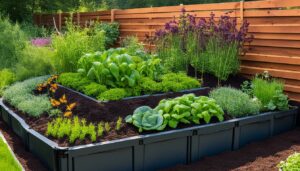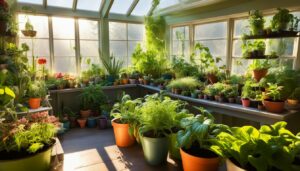Every gardener knows the crushing disappointment of tending to your plants only to find them besieged by pests. This is a story we all share—an ongoing battle between our desire for lush, healthy gardens and the ever-present threat of insects that can turn our hopes to dust. The idea of dousing our beloved plants with chemicals is equally disheartening, especially with our growing awareness of the importance of organic gardening and natural pest control for the health of our environment. But imagine, instead of reaching for that bottle of insecticide, you could employ nature’s own strategy with companion planting for pest control—a technique as ancient as the hills, that leans into the wisdom of biodiversity.
Sustainable gardening practices are not just a trend; they are a legacy we leave for the Earth and future generations. Through companion planting, we create a harmony in our garden that whispers to the very essence of nature’s intricate balance—a flourishing ecosystem that benefits not just our crops but also the planet.
Key Takeaways
- Companion planting is a cornerstone of organic gardening, promoting natural pest control without the need for harsh chemicals.
- Strategic plant partnerships can deter pests and attract beneficial insects, creating a self-regulating garden environment.
- A diverse selection of herbs, vegetables, and flowers is essential for an efficient and sustainable gardening practice.
- Historical and traditional knowledge plays a vital role in understanding how to effectively pair plants for the best defense against pests.
- Embracing companion planting contributes to the biodiversity of the garden and is a step forward in cultivating an eco-friendly world.
Understanding the Basics of Companion Planting for Pest Control
Plant partnerships in organic gardening are at the core of using companion planting as a means of natural pest control. By mindful arrangement of pest repellent plants alongside crops, gardeners can harness the strengths of nature to foster growth and deter pests, without relying on synthetic chemicals. We delve into the age-old technique that unites the wisdom of our ancestors with modern ecological knowledge to keep our gardens thriving.
What is Companion Planting and How Does it Work?
At its heart, companion planting is about creating a diverse garden ecosystem where plants perform multiple functions. This strategy involves positioning different species close together so that they may offer mutual benefits, such as pest control, improved pollination from beneficial insects, and enhanced growth. It’s a harmonious approach that underscores the interconnectivity of the living landscape.
Historical Roots: From the Three Sisters to Modern Gardens
Companion planting isn’t a new fad; it has sustained cultures for centuries. A notable example is the “Three Sisters” technique practiced by Native Americans, intertwining corn, beans, and squash. Each plant in this triad supports the others — corn provides a structure for beans to climb, beans bring nitrogen to the soil to benefit all, and squash with its broad leaves shades the soil, reducing weed growth and preserving moisture.
The Science Behind Plant Relationships and Pest Management
Understanding the science of companion planting can turn your garden into a natural pest deterrent. For example, blooms of chrysanthemums contain pyrethrins, naturally deterring many insects, and alliums release compounds from their roots that many pests find unpalatable. By studying these phenomena, gardeners can effectively utilize plants’ inherent pest management capabilities, reducing the need for artificial interventions.
| Pest Repellent Plant | Type of Pests Deterred | Companion Benefit |
|---|---|---|
| Marigolds | Nematodes, Aphids | Attracts pollinators and predatory insects |
| Alliums (Onions, Garlic) | Slugs, Carrot Fly | Repels pests with scent, improves soil quality |
| Chrysanthemums | Ants, Japanese Beetles | Source of natural insecticide (pyrethrins) |
| Basil | Mosquitoes, Whiteflies | Enhances flavor of tomatoes when planted nearby |
| Cosmos | Thrips | Attracts beneficial predator insects |
By integrating these methods into our organic gardens, we craft spaces not only bountiful and beautiful but also resilient against pests, all while fostering ecosystems where beneficial insects play their vital role.
Creating a Balanced Ecosystem with Diverse Planting
Embracing sustainable gardening practices means establishing a garden that nurtures a thriving ecosystem. By integrating a diverse array of flowers, herbs, and vegetables, gardeners not only cultivate a vibrant space but also employ a powerful strategy in organic gardening. This variety becomes a sanctuary for beneficial insects, promoting a natural balance that supports both plant health and pest management.

One of the core principles of creating a balanced ecosystem is to ensure that there is an assortment of plant life to serve varied roles within your garden. For instance, certain plants can serve as homes for predator insects that help control populations of harmful pests. These predators are a gardener’s allies, and enticing them into the space is a cornerstone of ecologically mindful plant care.
By cultivating cover crops like buckwheat and crimson clover, gardeners can further enhance their garden’s appeal to insect helpers. These crops offer additional benefits, such as improving soil health and preventing erosion, all while ensuring your garden is teeming with life and activity.
- Buckwheat attracts pollinators and predatory insects such as hoverflies.
- Crimson clover serves as a habitat for ground beetles and other beneficial species.
- Diverse planting confuses pests, making it harder for them to find target plants.
To illustrate the advantages of a diversified garden, the following table showcases some key cover crops and the beneficial insects they attract:
| Cover Crop | Beneficial Insects Attracted | Additional Benefits |
|---|---|---|
| Buckwheat | Pollinators (bees), hoverflies, parasitic wasps | Quick growth, improves soil composition |
| Crimson clover | Ground beetles, lacewings, ladybugs | Nitrogen-fixing, prevents soil erosion |
| White clover | Spiders, predatory mites, small wasps | Groundcover, drought-tolerant |
| Phacelia | Honeybees, mason bees, bumblebees | Excellent for pollinator support |
Ultimately, incorporating a diverse planting strategy is not just about pest control. It’s about building an oasis that honors the intricate web of life, ensuring a healthy and productive organic garden that can sustain itself with minimal human intervention while contributing positively to the local environment.
Beneficial Insects and How to Attract Them with Companion Planting
The foundation of vibrant organic gardening practices often relies on the natural equilibrium where beneficial insects play a pivotal role. By inviting these helpful creatures into your garden, you create a fortress against common pests through the thoughtful selection of plants and strategic intercropping. These beneficial inhabitants not only assist in pollination but also act as natural predators to pests, maintaining the delicate balance of your garden’s ecosystem.
The Role of Pollinators and Predators in Your Garden
Insects such as bees, butterflies, and ladybugs are essential for pollination, which is crucial for plant reproduction. In the pest control department, predators like praying mantises and lacewings keep the harmful insect population at bay, effectively reducing the need for chemical pesticides. By introducing a range of plants known to attract these allies, gardeners can harness the inherent power of nature for a flourishing garden space.
Selecting the Right Flowers to Support Beneficial Insects
When choosing flowering plants, one must consider not only the aesthetic appeal but also the ability to draw beneficial insects. Plants such as marigolds, nasturtiums, and cosmos are not only vibrant and fragrant additions to any garden but are also powerful allies in attracting insects that can keep pest populations under control. To assist in this selection, an informative table can guide organic gardeners toward making the best choices to welcome these pivotal creatures.

| Plant | Beneficial Insects Attracted | Pest-Repelling Properties |
|---|---|---|
| Marigold | Ladybugs, Bees, Hoverflies | Nematodes and other soil pests |
| Nasturtium | Bees, Hoverflies, Butterflies | Aphids, several varieties of beetles |
| Cosmos | Lacewings, Tachinid flies | Thrips and whiteflies |
| Mint | Syrphid flies, Bees | Aphids and cabbage moths |
| Dill | Bees, Hoverflies, Swallowtail butterflies | Spider mites, aphids, and caterpillars |
| Basil | Bees, Ladybugs | Mosquitoes and flies |
By intermixing these companions within your garden, you can enhance the health and productivity of your plants, naturally mitigating pest damage while supporting the ecosystem. The symbiotic relationship between these plants and beneficial insects is a cornerstone of robust organic gardening, paving the way for a sustainable, flourishing outdoor space.
The Art of Intercropping: Maximizing Space and Minimizing Pests
Intercropping, an age-old practice integral to sustainable gardening practices, serves as a beacon of efficiency and harmony in the plant kingdom. This method of companion planting for pest control stands out as a natural solution to common agricultural challenges, maximizing crop productivity while minimizing the need for chemical interventions.
By growing two or more crop species in close proximity, gardeners can exploit the symbiotic relationships between plants. This space-optimizing approach not only deters pests but also promotes a robust and diverse garden ecosystem. Let’s explore some practical examples that highlight the effectiveness of intercropping as a pest management strategy.
- Pairing radishes with cucumbers not only saves space but also acts to ward off beetle attacks, thanks to the radishes’ natural pest-repelling properties.
- Interspersing parsley among carrot rows can significantly reduce the presence of the dreaded carrot fly, a common bane for carrot enthusiasts.
Intercropping is not merely about combining any random crops but rather about understanding and implementing strategic partnerships that bring mutual benefits. Such combinations can often lead to unexpected and beneficial outcomes:
| Intercropped Companion | Main Crop | Targeted Pest |
|---|---|---|
| Celery | Cauliflower | White cabbage butterfly |
| Marigolds | Tomatoes | Nematodes and aphids |
| Nasturtiums | Broccoli | Aphids and beetles |
This strategic approach to planting takes full advantage of the natural defenses that plants can offer one another. By artfully managing the spatial arrangements of crops, one can create a lush, productive, and self-regulating garden ecosystem. Intercropping, as part of sustainable gardening practices, demonstrates that diverse and densely planted gardens can indeed flourish with minimal pest pressures, paving the way for a bountiful harvest.
The Best Plant Partnerships: Companion Planting for Specific Crops
Entering the world of organic gardening means forging powerful alliances between your plants. The ancient wisdom of plant partnerships plays a pivotal role in creating a thriving, pest-resistant garden. Certain herbs and vegetables stand guard beside their companions, forming a living, breathing fortress against unwanted invaders. Let’s delve into the synergy among these botanical allies to boost your garden’s health without a single drop of chemical pesticide.
Top Herb Companions and Their Pest-Repelling Properties
The herb garden is more than a culinary treasure trove; it is the frontline of defense in your garden. Herbs like basil not only bring flavor to your kitchen but also repel flies and mosquitoes, while lavender entices a battalion of pollinators and throws off the scent trails of garden pests. Bearing witness to the efficacy of pest repellent plants, gardeners can use nature’s own arsenal to fend off pests organically.
Crucial Combinations: Vegetables and Their Protective Allies
Imagine a vegetable plot buzzing with life, protected by its floral and herbal sentinels. This isn’t just a green fantasy; it’s a practical approach to gardening that harnesses the strengths of diverse species for a common goal. By introducing companion plants, each vegetable’s potential is maximized, making the most of space, nutrients and, importantly, organic pest control.
| Vegetable | Companion Plant | Benefit |
|---|---|---|
| Tomatoes | Basil | Repels thrips and flies; enhances flavor |
| Cabbage | Thyme | Deters cabbage worms |
| Zucchini | Marigolds | Prevents squash bugs |
| Carrots | Chives | Wards off carrot fly |
| Peppers | Parsley | Attracts beneficial insects |
Employing this method of companion planting for specific crops not only protects your cherished vegetables but also encourages a diverse ecosystem within your own backyard. This isn’t just gardening—it’s an exercise in creating a sustainable, self-sufficient haven of biodiversity.
Companion Planting for Pest Control: Tried and True Strategies
For gardeners embracing natural pest control, harnessing the power of companion planting for pest control is not a novel concept but rather a cornerstone of sustainable agriculture. This tried-and-true strategy hinges upon understanding the unique benefits that certain plant combinations provide. For instance, the vibrant marigold is more than just a splash of color in the garden; it’s a stalwart defender against intrusive pests. But simply planting and hoping for the best isn’t enough—it’s the careful observation and adaptation to local conditions that transform companion planting from folklore to a science.
Among the myriad of techniques, it’s the organic gardener’s wisdom to let their vegetables blossom, extending an open invitation to a host of beneficial insects whose presence in the garden is the first line of defense against pest invasions. Furthermore, the strategy of intercropping—planting alternate rows or interspersing plants—has proven its effectiveness by optimizing garden space and disrupting the habitat preferences of pests. Such practices underscore the importance of biodiversity and contribute to a healthier, more resilient garden ecosystem.
Aside from plant partnerships, embracing organic approaches completes the pest control puzzle; hand-picking pests, utilizing floating row covers, and fostering healthy soil through composting and mulching, all synergize with companion planting methods. By integrating these practices, gardeners can create a natural bulwark against pests, reducing the need for chemical interventions and contributing to a healthier environment. In essence, these multilayered strategies form the tapestry of a thriving organic garden, where each thread strengthens the collective resilience against pests.








